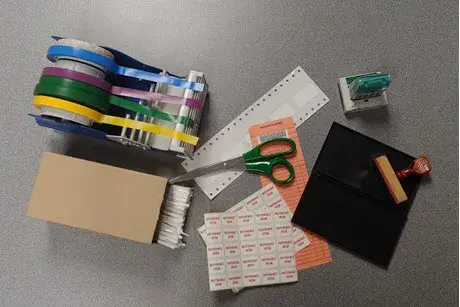The Path of a (New) Book: What People Think We Do vs. What We Actually Do

We are not sure what misconceptions people might have about the how library materials get to the shelves, but it is a complex process that we sometimes must complete in a matter of hours to get the new book in the hands of the patron who needs it for research or teaching. A new book follows a detailed process to ensure that the book can be easily identified, found, borrowed, and returned to its assigned location. This process involves the work of the Collection Services team.
We start our story at the time each item is ordered. The Collection Services librarian selects which items to purchase and orders them. As told in their own words, the selection and ordering process is more complicated than it sounds. After each book is ordered, a bibliographic record is obtained from a company called OCLC. There may be several records to choose; for our catalog we attempt to get the most complete record for each item we purchase. Occasionally, OCLC will not have a record and we will create a “stub record.” Stub records contain only the title, publisher, ISBN or other unique identifier, and imprint—which includes the date of publication, the publisher’s name, and the city where published.
Next, the item arrives in the mail. The Collection Services Assistant sorts the mail and checks-in items as needed. Next, they will stamp and apply security features to books. After this, the books go to the Catalog, Metadata, and Archives Librarian for additional processing and cataloging. See Cataloging: What People Think I Do vs. What I Actually Do for insights on the art of cataloging.
Assuming an item has been cataloged and a record is present in the library’s online catalog, the next step is to further process the book for use in the library. First, a barcode is placed on the inside of the front cover of the book or another suitable location that keeps it visible for the student employees at the circulation desk. The barcode is necessary for checking out an item.
Next, we locate the record in the catalog and create an “item record” that identifies the specific volume and determines whether it circulates and for how long. This seems a very easy feat, but it requires attention to rules for each book and filling out a template meticulously: entering the 14-character numeric barcode, volume information, date, and any other information that identifies the item at hand as a unique item. When all pertinent information has been created in the item record, it must be saved to become a permanent attachment to the bibliographic record.
After an item is barcoded and an item record created, the item is labeled for the stacks. A special label printer is used to produce the alpha-numeric call number label needed for the item. Once again, the bibliographic record is located. From there the item record is selected to print the label, using specialized software to extract the call number and format it on the label. After a label is printed, it is placed on the spine of the volume or the front cover of the volume. Other items may require a more creative location, ensuring that the label is visible so that patrons can find the item in the stacks and library staff can return the book to its proper location when it is returned. The last processing step is to add a label protector over the printed label to keep it from fading or falling off.
Once the books are labeled, they go to the circulation area. The circulation staff goes out to the stacks to shelve these items using their labels to place them in the appropriate section of the library.
Processing sounds like a simple thing but in the path of a book, detail oriented and accurate processing is essential for patrons to find the items they need in the library.


